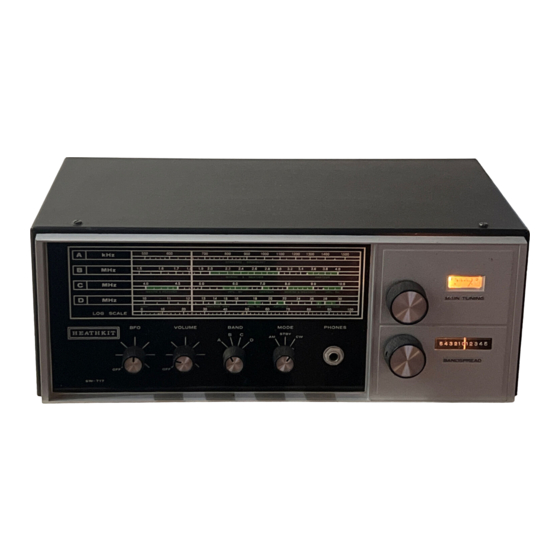Advertisement
Quick Links
HOM rev. new
Heathkit of the Month #92:
by Bob Eckweiler, AF6C
AMATEUR RADIO - SWL
Heathkit SW-717
General Coverage Communications Receiver.
Introduction:
Over its lifetime Heathkit Company manu-
factured 17 general coverage (GC) communi-
cations receivers. To be considered in this
arbitrary category the receiver must cover
the AM broadcast (BC) band and a signifi-
cant portion of the frequencies above it in the
HF range that ends at 30 MHz. The coverage
should be mostly continuous, though gaps for
technical reasons are acceptable
coverage, such as the LW band below the BC
band or frequencies above 30 MHz, is al-
lowed. Some of the included Heathkit GC re-
ceivers only cover to 10 MHz and others only
to 20 MHz. Superheterodyne receivers make
up 14 of the 17, the other three being super-
regenerative receivers. Ham-band only and
even band-oriented SWL receivers are not
considered general coverage, so you won't see
the SB receivers on the list.
Evidently, general coverage kit receivers
were a profitable product; they seemed to be
a popular beginner's kit as well as a moder-
ate kit for the more experienced kit builder.
Heath focused on having one or two receivers
on the market for the beginner, usually at
very reasonable prices for modest perfor-
mance. They also manufactured some higher
Here is a link to the index of Heathkit of the
Month (HotM) articles:
http://www.w6ze.org/Heathkit/Heathkit_Index.html
Copyright 2008 - 2017, R. Eckweiler & OCARC, Inc.
Heath of the Month #92 - SW-717 Communications Receiver
Figure 1: SW-717 General Coverage Receiver
Note substitute knob to left.
performance receivers as well as portable re-
ceivers that could run off batteries. Features
varied with cost; crystal filters, dual conver-
sion, S-meter, an RF amplifier stage and a
tracking bandspread control are often miss-
ing on the low-end radios.
The first receivers were the super-regenera-
tive K-1 and K-2 (HotM #s 80 & 81). They were
. Additional
1
followed by the superheterodyne AR-1
through AR-3. In 1960 Heath released their
first transistorized GC receiver, the Mohican
GC-1, later updated to the GC-1A (HotM #34).
As part of Heathkit's early educational series
they produced the EK-2A and EK-2B "Basic
Radio Educational Series" in two parts. In
part one the student builds various circuits
including a crystal receiver and later a re-
generative receiver. However, in part two the
receiver is modified and expanded into a six-
tube general coverage superheterodyne re-
ceiver that covers the broadcast band and 3
to 10 MHz; passing the GC requirements.
Around 1961 Heath started the GR receiver
line which includes general coverage short-
wave radios along with many other general
radios including clock radios and AM/FM
portables. Qualifying GC receivers from this
group are (in chronological order) the GR-81,
GR-91, GR-64, GR-54, GR-43[A] and GR-78
(HotM #62). The solid-state GR-43 and its 'A'
update are clones of the Zenith Transoceanic
Page ! of !
1
9
Advertisement

Summary of Contents for Heathkit SW-717
- Page 1 AM/FM portables. Qualifying GC receivers from this group are (in chronological order) the GR-81, Here is a link to the index of Heathkit of the Month (HotM) articles: GR-91, GR-64, GR-54, GR-43[A] and GR-78 (HotM #62). The solid-state GR-43 and its ‘A’...
- Page 2 SW-7800 in 1984, both solid-state. The Heathkit SW-717 General Coverage Communications Receiver: Figure 1 is a photo of the SW-717 receiver. It first appeared in the second half of-1971, too late to make the main 1971 catalog. In the...
- Page 3 HOM rev. new Heath of the Month #92 - SW-717 Communications Receiver The rear panel (Figure 2) is rather barren. Everything is located along the bottom edge. From left to right (as viewed from behind) is the ferrite rod antenna for the broadcast...
- Page 4 HOM rev. new Heath of the Month #92 - SW-717 Communications Receiver The Front End: Frequency Coverage: The front end normally designates every- Band A 550 kHz to 1500 kHz thing up to the first IF stage, usually the RF Band B 1.5 MHz to 4 MHz ...
- Page 5 HOM rev. new Heath of the Month #92 - SW-717 Communications Receiver adjust the main or band spread tuning. This recovered audio is fed to the VOLUME control takes some practice to be able to tune in an and to the audio amplifier circuit. In noisy SSB signal.
- Page 6 HOM rev. new Heath of the Month #92 - SW-717 Communications Receiver Building the SW-717: Heathkit advertised this radio as being a “Three Evening Kit”, the time in which the average builder could successfully assemble it. Much of the circuitry is located on a single circuit board.
- Page 7 HOM rev. new Heath of the Month #92 - SW-717 Communications Receiver Figure 6: An ad for the Heathkit SW-717 from the 1972 factory catalog #800/40 (page 30). stalled. The fiber board rear cover is added Final testing comes next with resistance and along with its ferrite rod antenna, wiring of voltage checks.
- Page 8 Interestingly, Heath uses two Figure 7: SW-717 under-chassis view. Bandspread capacitor is at the lower left. different types of pilot bulbs. The left bulb is a #53 and the Heathkit SW-717 ...
- Page 9 Instead of using pul- and all insulators and hardware. leys, as the main tuning does, the dial string 4. A copy of the SW-717 schematic is available on the is strung around three fixed posts, and W6ZE website at: ...





Need help?
Do you have a question about the SW-717 and is the answer not in the manual?
Questions and answers